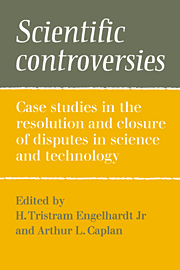 Scientific Controversies
Scientific Controversies Book contents
- Frontmatter
- Contents
- Preface
- List of contributors
- Introduction: Patterns of controversy and closure: the interplay of knowledge, values, and political forces
- PART I THEORETICAL PERSPECTIVES
- PART II CONTEMPORARY CASE STUDIES
- 12 Resolution of the Laetrile controversy: past attempts and future prospects
- 13 Federal regulation of Laetrile
- 14 Quasi libertarianism and the Laetrile controversy
- 15 Judicial deflection of scientific questions: pushing the Laetrile controversy toward medical closure
- 16 Politics, science, and the problem of psychiatric nomenclature: a case study of the American Psychiatric Association referendum on homosexuality
- 17 The diagnostic status of homosexuality in DSM-III: a reformulation of the issues
- 18 On arriving at the American Psychiatric Association decision on homosexuality
- 19 Values in the debate over workplace safety and health: the rancorous rhetoric about regulation
- 20 The successful experiment that failed
- 21 The power of efficiency: balancing benefits and costs in regulating occupational exposure to toxic substances
- 22 Closure in occupational safety and health: the benzene and cotton dust decisions
- 23 Nuclear fear: a history and an experiment
- 24 Closure and controversy: Three Mile Island
- 25 Understanding the nuclear power controversy
- PART III CONTROVERSY, CLOSURE, AND THE PUBLIC
- Author index
- Subject index
23 - Nuclear fear: a history and an experiment
Published online by Cambridge University Press: 03 February 2010
- Frontmatter
- Contents
- Preface
- List of contributors
- Introduction: Patterns of controversy and closure: the interplay of knowledge, values, and political forces
- PART I THEORETICAL PERSPECTIVES
- PART II CONTEMPORARY CASE STUDIES
- 12 Resolution of the Laetrile controversy: past attempts and future prospects
- 13 Federal regulation of Laetrile
- 14 Quasi libertarianism and the Laetrile controversy
- 15 Judicial deflection of scientific questions: pushing the Laetrile controversy toward medical closure
- 16 Politics, science, and the problem of psychiatric nomenclature: a case study of the American Psychiatric Association referendum on homosexuality
- 17 The diagnostic status of homosexuality in DSM-III: a reformulation of the issues
- 18 On arriving at the American Psychiatric Association decision on homosexuality
- 19 Values in the debate over workplace safety and health: the rancorous rhetoric about regulation
- 20 The successful experiment that failed
- 21 The power of efficiency: balancing benefits and costs in regulating occupational exposure to toxic substances
- 22 Closure in occupational safety and health: the benzene and cotton dust decisions
- 23 Nuclear fear: a history and an experiment
- 24 Closure and controversy: Three Mile Island
- 25 Understanding the nuclear power controversy
- PART III CONTROVERSY, CLOSURE, AND THE PUBLIC
- Author index
- Subject index
Summary
Powerful emotions permeate the debate over nuclear energy. Anxiety and anger are evident in all the songs and shouts of antinuclear rallies, and at meetings where pronuclear engineers and executives gather, there too one may sense, beneath the controlled language, anxiety and anger. Perhaps this emotion is an uninteresting side effect such as may attend any debate that waxes strong. But what if the emotion is fundamental? What if there are feelings about nuclear energy that motivate the debate itself, so that the arguments over politics, values, and scientific claims are the side effects, the symptoms of a deeper conflict? Until we understand the origin and nature of the emotions aroused by nuclear energy, we cannot be confident that we know how to bring the nuclear debate to a satisfactory resolution.
Historical methods offer promise of uncovering the origin of these emotions, for as we go back in time, we can slough away transient phenomena that confuse the current scene. The reader must be warned, however, that the history of emotion is a field in its infancy. Not only in our subject matter but in our methodology, we enter uncharted waters.
When radioactivity was discovered in a few rare ores, the phenomenon was not at first recognized as separate from other newly famous forms of radiation such as radio and X-rays. Only around 1900 did radioactivity begin to arouse interest, when radium, an intensely radioactive element, became known. Among the interested scientists were Ernest Rutherford and Frederick Soddy, who late in 1901 made a revolutionary discovery: Radioactivity signals atoms that are changing from one element into another.
- Type
- Chapter
- Information
- Scientific ControversiesCase Studies in the Resolution and Closure of Disputes in Science and Technology, pp. 529 - 550Publisher: Cambridge University PressPrint publication year: 1987
- 5
- Cited by
